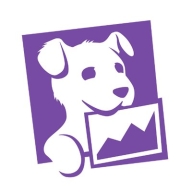

Datadog and NetApp Cloud Insights compete in the field of monitoring and analytics for cloud and on-premises environments. Datadog emerges with a broader integration capability and user-friendly visualization tools, while NetApp Cloud Insights is more specialized for NetApp environments, leading in cases where users are invested in NetApp solutions.
Features:Datadog includes hosted management, sharable dashboards, customizable monitoring alerts, and seamless integrations with various services. Users appreciate its ease of use and powerful visualization tools for simplifying metric aggregation across multiple environments. NetApp Cloud Insights provides strong visibility and analysis across cloud and on-premises settings, focusing on NetApp products with detailed dashboards and visualization tools tailored to those familiar with NetApp storage solutions.
Room for Improvement:Datadog users seek improvements in query performance, enhanced cost visibility, and better UI navigation. There is also a demand for more mobile application features and security enhancements. Pricing transparency is another concern. NetApp Cloud Insights users look for better ease of reporting, simpler licensing, and improved anomaly detection features, as well as enhanced integration capabilities in multi-vendor environments.
Ease of Deployment and Customer Service:Datadog generally supports a wide range of environments like public, private, and hybrid clouds, where users are satisfied with its deployment flexibility. Customer service is praised for response time, although technical support consistency needs improvement. NetApp Cloud Insights receive positive feedback for customer service, especially for integration with NetApp solutions, though complexities can arise in hybrid or on-premises deployments.
Pricing and ROI:Datadog's pricing is considered premium with a usage-based model, which can lead to unexpected costs if not carefully monitored. Despite this, users report a positive ROI due to enhanced monitoring and time savings. NetApp Cloud Insights offers cost benefits for existing NetApp users as it can be used freely with NetApp products, but its capacity-based pricing necessitates understanding to avoid unexpected expenses. NetApp emphasizes infrastructure efficiency and workload optimization for cost savings.


Datadog is a comprehensive cloud monitoring platform designed to track performance, availability, and log aggregation for cloud resources like AWS, ECS, and Kubernetes. It offers robust tools for creating dashboards, observing user behavior, alerting, telemetry, security monitoring, and synthetic testing.
Datadog supports full observability across cloud providers and environments, enabling troubleshooting, error detection, and performance analysis to maintain system reliability. It offers detailed visualization of servers, integrates seamlessly with cloud providers like AWS, and provides powerful out-of-the-box dashboards and log analytics. Despite its strengths, users often note the need for better integration with other solutions and improved application-level insights. Common challenges include a complex pricing model, setup difficulties, and navigation issues. Users frequently mention the need for clearer documentation, faster loading times, enhanced error traceability, and better log management.
What are the key features of Datadog?
What benefits and ROI should users look for in reviews?
Datadog is implemented across different industries, from tech companies monitoring cloud applications to finance sectors ensuring transactional systems' performance. E-commerce platforms use Datadog to track and visualize user behavior and system health, while healthcare organizations utilize it for maintaining secure, compliant environments. Every implementation assists teams in customizing monitoring solutions specific to their industry's requirements.
NetApp Cloud Insights is an infrastructure monitoring tool that gives you visibility into your complete infrastructure. With Cloud Insights, you can monitor, troubleshoot and optimize all your resources including your public clouds and your private data centers.
We monitor all IT Infrastructure Monitoring reviews to prevent fraudulent reviews and keep review quality high. We do not post reviews by company employees or direct competitors. We validate each review for authenticity via cross-reference with LinkedIn, and personal follow-up with the reviewer when necessary.